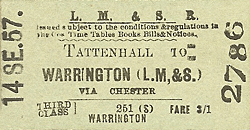
Station Name: TATTENHALL
|
| Date opened: | 1.10.1872 |
| Location: | North side of Frog Lane |
| Company on opening: | London & North Western Railway |
| Date closed to passengers: | 16.9.1957 |
| Date closed completely: | 16.9.1957 |
| Company on closing: | British Railways (London Midland Region) |
| Present state: | The station building survives as a private residence although it has been substantially altered and extended. |
| County: | Cheshire |
| OS Grid Ref: | SJ479586 |
| Date of visit: | 28.5.2006 |
Notes: Tattenhall Station was located on the LNWR’s line that ran from a junction on the Crewe to Chester line, approximately two miles to the north of Tattenhall Village, to the market town of Whitchurch. The line was opened by the LNWR on 1st October 1872 and it was 14 miles in length and built to main line standards with double track throughout. It was intended to provide competition to the GWR route between Chester and Shrewsbury and the LNWR hoped that it would attract the majority of the coal traffic from South Wales which was destined for the Mersey Docks in Birkenhead. Some coal traffic did use the line, especially that originating from the Abergavenny - Merthyr line which was also under LNWR control .However most of the coal traffic bound for Birkenhead came from the North Wales coal fields around Wrexham which was GWR or GCR territory, this did not use the Whitchurch - Waverton line
Tattenhall would be one of the very few villages in England that could boast of two LNWR stations both on differing routes; however neither were conveniently near to the village itself. There were no goods facilities here, the yard at Tattenhall Road station on the main (Chester – Crewe) line serving the village despite its greater distance from it.
Passenger train services were mostly of a local nature running between Chester and Whitchurch. Connections were possible to Liverpool and the area became popular with many businessmen who commuted by train. In 1922 there were seven daily trains in each direction, by 1950 this was reduced to five daily trains with an additional service on Wednesdays running through to Shrewsbury. There was never a Sunday service.
Additional source: London & North Western Railway Society Journal September 2004 and Backtrack magazine March 2007, thanks to Tony Robinson for sending his text from these journals. Further reading: Down the Line by RM Bevan - A nostalgic journey along the old branch railway from Waverton (Chester) to Whitchurch, CC Publishing. Tickets from Michael Stewart To see other stations on the Waverton - Whitchurch line click on the station name: Whitchurch, Grindley Brook Halt, Malpas, Broxton & Waverton |

Reproduced with permission from 'Down The Line - A nostalgic journey along the old branch railway from Waverton to Whitchurch', by R.M.Bevan (www.cc-publishing.co.uk)
3.jpg)
Photo by Rick Skateboard from his Fotopic web site
5.jpg)
Photo by Paul Wright
 |
| Last updated: Friday, 04-Jan-2019 00:23:53 CET | © 1998-2009 Disused Stations |





1.jpg)
thumb2.jpg)
thumb4.jpg)
 Home Page
Home Page